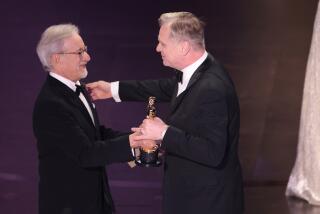Andy Serkis of ‘Apes’ being promoted for Oscar
Oscar’s supporting actor race will be a hairy one this year — and something of a digital proving ground. Andy Serkis, who played Caesar, the hyper-intelligent chimp in this summer’s “Rise of the Planet of the Apes,” is getting an awards push courtesy of 20th Century Fox.
Serkis’ performance — which tracks Caesar from his childhood raised by a human scientist (James Franco) through his political awakening as an adult chimp in a cruelly run primate sanctuary — was delivered via the same computer-graphics techniques used in “Avatar.”
Fox’s campaign for Serkis will test Oscar voters’ willingness to acknowledge actors’ work in the increasingly common performance capture field, in which the actions of human actors are recorded and used to animate digital character models. In Serkis’ case, artists at the visual effects house Weta Digital transformed him from a curly-haired Englishman into a knuckle-dragging chimpanzee. Like John Hurt’s Oscar-nominated performance in “The Elephant Man” in 1980, in which he was rendered unrecognizable by heavy prosthetic makeup, acknowledging the performance would require academy voters to take note of an actor without ever seeing his face.
Of “Avatar’s” nine Academy Award nominations in 2010, none was for acting, and at the time of that film’s release, many in Hollywood expressed skepticism about the nascent medium.
“Our job is to try to have people be aware of and recognize great performances, even when they come in this case in an unusual skin,” said Tom Rothman, co-chairman and CEO of Fox Filmed Entertainment. “I think it’s one of the great emotional performances ever. The challenge is to overcome preconceptions and certain prejudices, to have people understand that … the emotionality of the character on screen is not provided by the animators, it’s provided by the actor.”
For Serkis’ campaign, Fox will hold screenings at the Screen Actors Guild and the Academy of Motion Picture Arts and Sciences, Rothman said, with Serkis participating in Q&As via satellite from the set of Peter Jackson’s “The Hobbit” in New Zealand, where he is reprising his role of Gollum from the “Lord of the Rings” trilogy and serving as second unit director. The studio will also make materials available in “for your consideration” ads showing how Serkis’ performance in “Apes” looked before the artists at Weta enhanced it.
In the last decade, Serkis, 47, has become the public face of the largely anonymous craft of digitized acting — his portrayal of Gollum was the first motion capture role to attract attention for its depth of expression, and his work in the title role of Jackson’s “King Kong” advanced the technique with greater emphasis on facial performance, as opposed to just bodily movement. Serkis helped make “Apes,” a reboot of the 1960s science-fiction franchise by director Rupert Wyatt, one of the summer’s surprise critical and commercial hits, and he is the first cast member the studio has signed for a sequel.
Serkis also appears in another high-profile performance capture role this year as seafaring sidekick Captain Haddock in Steven Spielberg’s “The Adventures of Tintin,” which opens in the U.S. in December. In a demonstration of the way the technique blurs the lines between animation and live-action filmmaking, Paramount is campaigning that movie as an animated film in the awards race, and so far has not revealed any major push for its actors.
Serkis said the acknowledgment of his “Apes “performance is welcome for what it says about the industry’s evolving view of performance capture.
“For many years talking about Gollum, it was about the technology, the how of it all,” Serkis said in an interview from the “Hobbit” set in late October. “Performance capture was an exotic, strange activity, separated from the craft of acting. People thought when I was doing Gollum, ‘What is he? Is he a contortionist or a dancer or a circus performer? How does he fit into the process?’ Ten years down the line it’s become an industry standard and it’s more about talking about character.”
If there is increasing acceptance of performance capture in Hollywood, that’s largely due to the work of a few tall, blue aliens, according to Woody Schultz, chairman of the Screen Actors Guild’s Performance Capture Committee, which formed in 2010 in the wake of the questions the guild’s members had about “Avatar.” (Serkis’ work is also eligible for a SAG award, which the guild confers in January. Neither SAG nor the academy has a special category for performance capture acting, although at one point “Polar Express” director Robert Zemeckis pushed for the academy to create one).
“There was a lot of fear in the acting community that this technology would somehow displace actors,” said Schultz, who played multiple performance capture roles in “Avatar,” “Beowulf” and “The Adventures of Tintin.” “Now people are becoming more savvy. They have a greater understanding of it. Part of it is thanks to the overwhelming success of ‘Avatar.’ [Director] James Cameron and [producer] Jon Landau really demystified the process.”
“‘Avatar’ was the first of its kind and so there was a learning process involved,” Rothman said. (Fox released “Avatar” as well.) “I’m optimistic that people understand this now. I believe that the academy is very adventurous.”
On Nov. 9, SAG will hold a Q&A for its members on performance capture, the latest of several events to address members’ curiosity about the technique. The concerns actors have had evolved in the nearly two years since the release of “Avatar,” Schultz said. “The most common question I get now is, ‘How do I break into it?’” he said.
More to Read
The biggest entertainment stories
Get our big stories about Hollywood, film, television, music, arts, culture and more right in your inbox as soon as they publish.
You may occasionally receive promotional content from the Los Angeles Times.











